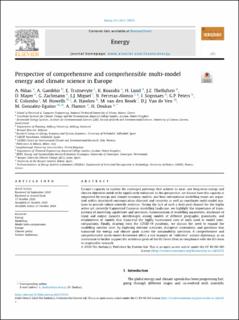Perspective of comprehensive and comprehensible multi-model energy and climate science in Europe
| dc.contributor.author | Nikas, A. | |
| dc.contributor.author | Gambhir, A. | |
| dc.contributor.author | Trutnevyte, E. | |
| dc.contributor.author | Koasidis, K. | |
| dc.contributor.author | Lund, H. | |
| dc.contributor.author | Thellufsen, J.Z. | |
| dc.contributor.author | Mayer, D. | |
| dc.contributor.author | Zachmann, G. | |
| dc.contributor.author | Miguel, L.J. | |
| dc.contributor.author | Ferreras-Alonso, N. | |
| dc.contributor.author | Sognnæs, Ida Andrea Braathen | |
| dc.contributor.author | Peters, Glen Philip | |
| dc.contributor.author | Colombo, Emanuela | |
| dc.contributor.author | Howells, M. | |
| dc.contributor.author | Hawkes, A. | |
| dc.contributor.author | van den Broek, M | |
| dc.contributor.author | Van de Ven, D.J | |
| dc.contributor.author | Gonzalez-Eguino, M. | |
| dc.contributor.author | Flamos, A. | |
| dc.contributor.author | Doukas, H. | |
| dc.coverage.spatial | Europe | en_US |
| dc.date.accessioned | 2022-01-25T13:52:01Z | |
| dc.date.available | 2022-01-25T13:52:01Z | |
| dc.date.created | 2021-05-13T15:59:52Z | |
| dc.date.issued | 2021 | |
| dc.identifier.citation | Energy. 2021, 215 1-8. | en_US |
| dc.identifier.issn | 0360-5442 | |
| dc.identifier.uri | https://hdl.handle.net/11250/2839267 | |
| dc.description.abstract | Europe’s capacity to explore the envisaged pathways that achieve its near- and long-term energy and climate objectives needs to be significantly enhanced. In this perspective, we discuss how this capacity is supported by energy and climate-economy models, and how international modelling teams are organised within structured communication channels and consortia as well as coordinate multi-model analyses to provide robust scientific evidence. Noting the lack of such a dedicated channel for the highly active yet currently fragmented European modelling landscape, we highlight the importance of transparency of modelling capabilities and processes, harmonisation of modelling parameters, disclosure of input and output datasets, interlinkages among models of different geographic granularity, and employment of models that transcend the highly harmonised core of tools used in model inter-comparisons. Finally, drawing from the COVID-19 pandemic, we discuss the need to expand the modelling comfort zone, by exploring extreme scenarios, disruptive innovations, and questions that transcend the energy and climate goals across the sustainability spectrum. A comprehensive and comprehensible multi-model framework offers a real example of “collective” science diplomacy, as an instrument to further support the ambitious goals of the EU Green Deal, in compliance with the EU claim to responsible research. | en_US |
| dc.language.iso | eng | en_US |
| dc.publisher | Elsevier | en_US |
| dc.rights | Navngivelse 4.0 Internasjonal | * |
| dc.rights.uri | http://creativecommons.org/licenses/by/4.0/deed.no | * |
| dc.subject | Energy | en_US |
| dc.subject | Modelling | en_US |
| dc.subject | Model inter-comparisons | en_US |
| dc.subject | Europe | en_US |
| dc.subject | Climate policy | en_US |
| dc.subject | Science diplomacy | en_US |
| dc.title | Perspective of comprehensive and comprehensible multi-model energy and climate science in Europe | en_US |
| dc.type | Journal article | en_US |
| dc.type | Peer reviewed | en_US |
| dc.description.version | publishedVersion | en_US |
| dc.source.pagenumber | 1-8 | en_US |
| dc.source.volume | 215 | en_US |
| dc.source.journal | Energy | en_US |
| dc.identifier.doi | 10.1016/j.energy.2020.119153 | |
| dc.identifier.cristin | 1909919 | |
| dc.relation.project | EC/H2020/820846 | en_US |
| cristin.ispublished | true | |
| cristin.fulltext | original | |
| cristin.qualitycode | 2 |
Tilhørende fil(er)
Denne innførselen finnes i følgende samling(er)
-
Journal articles [478]

